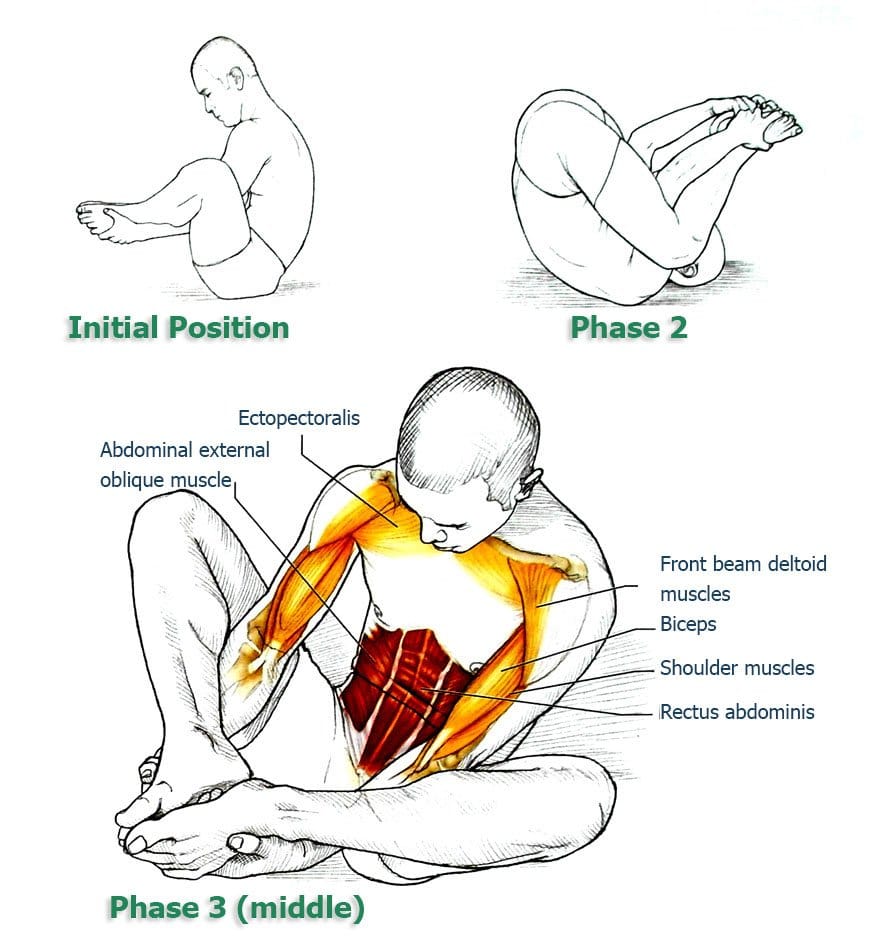Improve Flexibility and Movement of Your Back and Spine
Welcome back to our exercise program to improve flexibility and movement precision of your back and spine. Hopefully you enjoyed Rolling Over as we now continue with the next exercise in the program, the Seal.
The series so far:
- Exercise #1: Rolling Over
- Exercise #2: Seal (you are here)
- Exercise #3: Crab
- Exercise #4: Rocking Chair
- Exercise #5: Extended Legs Back Roll
- Exercise #6: Boomerang
- Exercise #7: Controlled Balance
- Exercise #8: Jackknife
Exercise #2: Seal

Initial position. Sit on an exercise mat and, pulling your knees to your chest and spreading them wider than shoulder width. Place your heels together. Bend the spine over the entire length, so that it takes the form of the letter “C”. Put your hands between your legs and grasp the outside of the foot. Lift the feet on the mat, so that the entire body weight is placed on the buttocks:
- Breathing-in, roll back backwards;
- Breathing-out, roll forward to the starting position and clap twice with your feet. Repeat the exercise 10 times a seal.
Make Sure You:
- In the 1st phase of the Seal, use the abdominal muscles to tilt the pelvis back and bend your spine evenly in the form of the letter “C” along the entire length – from the head to the tailbone. At the same time pull-in your belly, pulling the front the abdomen towards the spine. Use the leg extensor muscles in the hip to lift your feet from the mat and bring the thigh close to the chest. Use your arms to help keep the legs close to the body;
- At the beginning of the 2nd phase, give a stronger pull to your stomach and tilting your pelvis back – roll back on the mat;
- To facilitate the transition of the return movement in the 3rd phase of the exercise, use the leg extensor muscles in the hip and thighs to take them a little further from the chest (with the arms restricting the movement). Arm extensors in the shoulder joint pull your feet in a downward direction. At the same time, by pulling on the abdominal muscles even more, bend in the lumbar spine and torso forward;
- Try to maintain your posture during the rolling;
- Return to the initial position and restore the balance by double clapping the feet. The movement should be performed quickly and dynamically;
- In order to achieve a soft rolling, imagine that your back is the surface of a ball, wheel or hoop which rolls along the ground without changing its shape.
Additional Notes
This exercise is very similar to Rolling Over and just as good at stretching the spine extensor muscles. It develops coordination work of the abdominal muscles and develops the skills to use movement inertia and maintaining balance. An additional difficulty arises when, after returning to the original position, you need to double clap the feet. Such a move could upset the balance and the bent position of the spine. Overall, a great challenge and skill to improve flexibility and movement of your spine and back.
Optional
To increase the complexity of the exercise, clap your feet three times after rolling back and then again after returning to the starting position. To do this, you need to pause before proceeding to the return movement.
Once mastered, go for the next exercise in the program.

